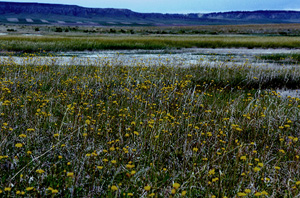Community Field Guide
Scientific Name:
Sporobolus airoides Herbaceous Vegetation
Common Name:
Alkali sacaton Southern Plains grassland
Community Description
Summary:
This alkali sacaton mesic grassland community is found in the southwestern Great Plains, in the southwestern United States, and Mexico. Stands occur on slightly to moderately saline, nearly level bottomlands and terraces. Substrates are shallow, moderately well- to poorly drained, silty clay soils formed in alluvium. The community is dominated by medium-tall and short grasses. Sporobolus airoides is a dominant, often accompanied by Symphyotrichum subulatum (= Aster subulatus), Pascopyrum smithii, Buchloe dactyloides, Distichlis spicata, Hordeum jubatum, and Bouteloua gracilis.
Environment:
This grassland community occurs on alluvial toeslopes and flats, floodplain depressions, and on sandy streambanks in bottomlands throughout the southern Great Plains and Colorado Plateau. Elevations range from below 1000 m to over 2000 m . Sites are nearly level, and soils are typically fine-textured silts or clays often derived from shale. Substrates are shallow to moderately deep, moderately well- to poorly drained, alkaline, and often saline.
Vegetation:
This association is characterized by a sparse to moderately dense (20-60% cover), medium-tall graminoid layer dominated by Sporobolus airoides. Associated species include Symphyotrichum subulatum (= Aster subulatus), Buchloe dactyloides, Distichlis spicata, Hordeum jubatum, Bouteloua gracilis, Panicum obtusum, Pleuraphis jamesii, Sporobolus cryptandrus, and Pascopyrum smithii (Lauver et al. 1999). Scattered Atriplex canescens or Sarcobatus vermiculatus shrubs may be present. Forb cover is minor.
Range:
This alkali sacaton mesic grassland community is found in the southwestern Great Plains and elsewhere in the southwestern United States and Mexico, ranging from Kansas and Colorado south to Texas, New Mexico (Rio Puerco, Otero County, in Ecoregion 24), and possibly California.
Dynamics:
This is an early-seral community that occurs on floodplains and depressions with moderately saline soils (Aldous and Shantz 1924 as cited in Johnston 1987). While the stand sampled may be flooded infrequently, other stands of Sporobolus airoides (alkali sacaton) are reported to occur on soils not flooded but with often high water tables because of land position. The intermittent flood regime affects soil moisture and salinity which can alter species composition. Sudden increases in salinity will result in a decrease in cover of Sporobolus airoides. With no change in salinity, this plant association will form hummocks that accumulate sand. Gradually the sites will decrease in salinity, and moisture and invasion by other grasses will follow (Ungar 1974a as cited in Johnston 1987). Soils are non-saline to moderately saline to usually alkaline. Sporobolus airoides will decrease in abundance with increased soil salinity.
Global Rank: G3Q State Rank: S2
Global Rank Comments:
The number of occurrences is unknown. The community is reported from Colorado (S3), Kansas (SP), New Mexico (S2), Texas (S?), and Mexico (S?) and may occur in California (SP). The community is found on slightly to moderately saline, nearly level bottomland and terraces with alluvial silty clay soils.
Community References
Identifier:
CEGL001685
Author:
J. Drake, mod. K. Schulz
Citations:
Aldous and Shantz 1924, Bourgeron and Engelking 1994, Driscoll et al. 1984, Francis 1986, Johnston 1987, Kittel and Lederer 1993, Kittel et al. 1999, Lauver et al. 1999, Lindauer 1970, Soil Conservation Service 1978, Steward 1982
View Detailed Citation Information | New Community Search | NatureServe Explorer Community Information
This information is from the:
Montana Natural Heritage Program
Montana State Library--Natural Resource Information System
1515 East Sixth Ave., Helena, MT 59620-1800
406 444-3989
mtnhp.org
mtnhp@mt.gov






